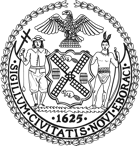Investment Priorities
Investment Priority 2:
Strengthen public health and safety
The City will support the health of New Yorkers by strengthening our health and hospitals system, improving the quality of and access to outdoor public space, investing in heat mitigation and cooling infrastructure, and continuing to improve our multimodal transportation network.
Strengthening our health and hospitals system
In the last year, nearly 850,000 New Yorkers (10% of the population) have been infected with COVID-19 and almost 100,000 have been hospitalized. Not all populations and neighborhoods were affected equally. COVID-19 illuminated longstanding health inequities by race, ethnicity, and neighborhood.
Lessons from COVID-19 will influence how we plan for long term investments in our hospitals and other health-related facilities and ensure that facilities are better-equipped to handle future emergencies and meet New Yorkers’ ongoing healthcare needs. In response to COVID-19, H+H will continue its air quality enhancement investments system-wide. It is also considering identifying renovations that will create more single in-patient rooms and realign inpatient critical care areas to facilitate critical care collaboration and efficient operations. H+H is also focused on bringing primary care facilities to select neighborhoods that lack this service, often those most impacted by COVID-19, through mobile health units or comprehensive health centers.
Improving and expanding outdoor public space
COVID-19 also underscored that investment in outdoor public space is an investment in our health. Our parks, plazas, sidewalks, and even streets provide essential, safe space for recreation, exercise, and socializing.
City agencies are responding to the increased need for well ventilated public space during the COVID-19 pandemic by allowing more flexible uses of our existing outdoor infrastructure. SCA invested in outdoor recreational facilities such as playgrounds and athletic fields that serve both students and local residents (during non-school hours). City programs support the transformation of existing assets into multifunctional outdoor spaces, such as the DOT Open Streets program which closes streets to cars to create open space for pedestrians, and is being expanded to increase participation of historically underserved neighborhoods. The City has other programming efforts to expand and transform how public space can be used, including an expanded Privately Owned Public Spaces (POPS) and Cool Streets programs.
The City has continued to work on plans for future additions to our public space, such as with the proposed Gowanus Waterfront Action Plan (part of the larger Gowanus rezoning). The Plan will generate four acres of new waterfront open space with esplanade areas elevated to respond to long-term daily tidal flooding. The Plan will also incentivize private developers to incorporate community amenities like comfort stations, boat launches, and historic interpretation elements. The Plan also calls for public investments in new waterfront open space, City-owned street ends, and design interventions around bridge crossings to support the overall vision of a safe, resilient and active waterfront esplanade. (see call-out box on DPR’s Approach to Equity for more information).
Improving our multimodal transportation network
In the next decade we will invest in the City's many interconnected transportation options to help more New Yorkers access essential services, go to work, and move about the city. This will include continued investment in much-needed safety improvements to our streets, bike lanes, and pedestrian walkways through DOT's Vision Zero initiative, which continues to show progress since launching in 2014. In February 2019, the DOT released a new Borough Pedestrian Safety Plan, which targets the next set of streets, intersections, and areas that will be the focus of Vision Zero initiatives. Since 2015, there has been a 36% decrease in pedestrian fatalities. This TYCS has committed $3.6 billion in street reconstruction projects of which $1.54 billion will be dedicated to ongoing and new Vision Zero projects citywide.
The City's investment strategies are taking into account dynamic shifts in travel patterns. For instance, ridership trends during the pandemic showed that when the stay-at-home order was lifted, subway and bus ridership remained substantially lower than normal while Citi Bike and ferry ridership pointed to a general interest in outdoor travel options. DOT continues to enhance the pedestrian, transit, and bicycle network citywide, in addition to planning for multiple other accessibility, safety, and transit improvements as part of the NYC Streets Plan legislation enacted in 2019. This is complemented by the Citi Bike program, which is growing to serve a wide range of neighborhoods, often those with fewer transportation options, in its ongoing Phase 3 expansion. We are also continuing to invest in NYC Ferry, which connects neighborhoods to job centers and brings much needed transit access to NYC's waterfront and recreational areas. The NYC Ferry is in the midst of an expansion that will allow its service to connect all five boroughs. The City has committed $273.9 million toward the purchase of new ferries, infrastructure improvements to bulkheads and piers, and investments to strengthen the City's waterfront assets for public, commercial, and recreational uses.
We are also working to bring the city's existing transit network to more New Yorkers by investing in accessibility improvements (see call-out box on Accessibility Initiatives) and expanding DOT programs with an eye towards equity (see call-out box on DOT Approach to Equity).
